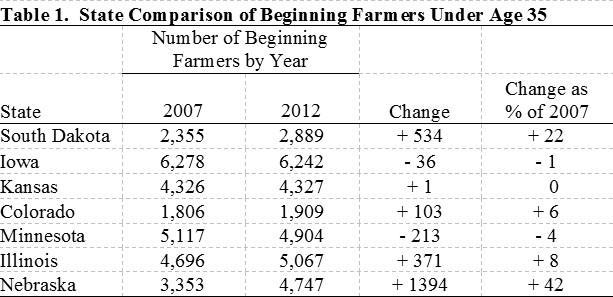Cornhusker Economics October 1, 2014
Beginning Farmer Numbers Grow in Nebraska
According to the 2012 USDA Census of Agriculture, a 30-year trend of declining numbers of farmers under 35 years of age appears to be, at least temporarily, reversing. As Figure 1 shows, Nebraska's principal farm/ranch operators in the age group under 35 grew by 1,394 - from a total of 3,353 in 2007 to 4,747 in 2012. The previous 20-year history indicated overall losses in the number of beginning farmers from 12,609 in 1987 to a low of 3,353 in 2007.

Nebraska's total number of farm/ranch operators in the state grew as well, moving from 47,712 in 2007 to 49,969 in 2012 also apparently reversing a long-term trend of fewer and fewer farm operators in Nebraska.
Figure 2 also demonstrates the long-term trend regarding the growing number of principal farm operators over the age of 65. The trend continues to indicate a rising number of older operators. The effect of this is a concentration of agricultural assets, such as land, machinery and livestock, in older hands. Examining 2012 operators as a percentage of the 1982 operators demonstrates that there has been a reduction in under 35 operators of nearly 65 percent while the over-65 operator group has increased by 50 percent.

Certainly farm profitability has significantly impacted long-term trends regarding the age of operators. Another factor may be the rise in popularity of farmer's markets and the buy local phenomena. The increase in the labor-intensive organic or direct marketing type of farming is naturally suited for beginners. This type of farming operation requires lower capital investment while demanding more physical labor. That mix is well suited for beginners. One can also argue that programs such as Nebraska's Beginning Farmer Tax Credit Program and USDA's beginning farmer programs such as Transition Incentives Program and Farm Service Agency beginning farmer loans have had a beneficial effect as well.
Table 1 demonstrates the change in the number of principal operators in the under 35 age group from the 2007 Census of Agriculture to that of 2012. Nebraska shows an increase of 1,394 compared with South Dakota's increase of 534. Illinois shows an increase of 371 and Colorado shows an increase of 103. Kansas gained 1 beginner while both Iowa and Minnesota lost 36 and 213, respectively.

Even though there is some light at the end of the tunnel with the increase in younger operators in Nebraska, much still needs to be done to encourage older farm operators to mentor and coach a successor so their farming or ranching business has a chance to continue after the retirement and/or death of the older operator. The health of rural Nebraska's communities depends on viable farming businesses succeeding in the future.
Dave Goeller
Transition Specialist
Deputy Director
North Central Extension Risk Management Education Center
dgoeller@unl.edu